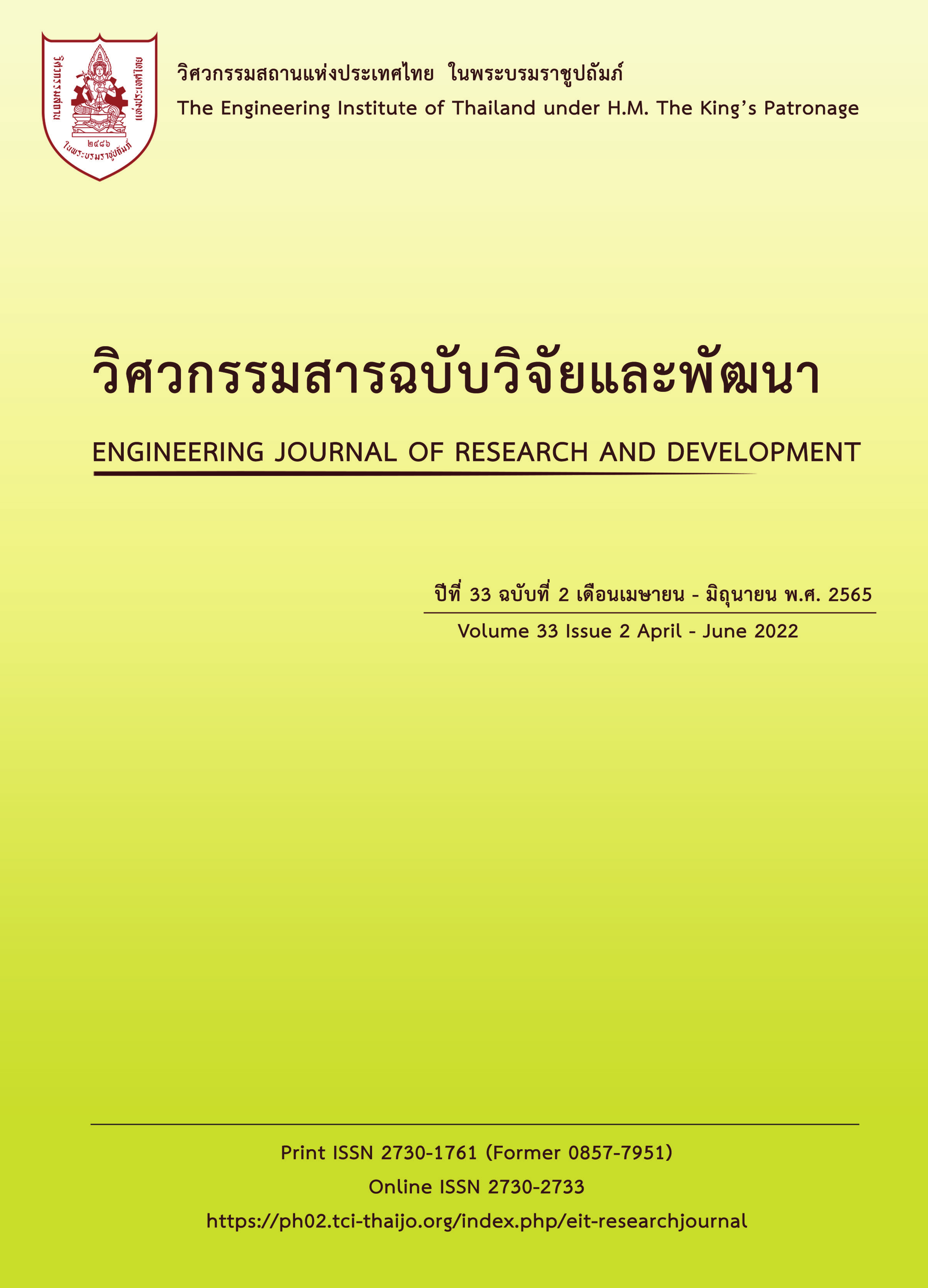FIELD INVESTIGATION OF SALINITY INTRUSION CHARACTERISTIC PATTERNS IN THE VICINITY OF BANGPAKONG ESTUARY ---
Main Article Content
Abstract
Salinity intrusion is a natural phenomenon that occurs in channels, and its patterns vary depending on areas and landscape. This paper aims to study the salinity intrusion distribution patterns of the vicinity of Bangpakong estuary in different seasons by using field investigation and corrected the secondary field data in order to explain the characteristic pattern of saltwater intrusion of Bangpakong River. The results of this study could provide crucial information for gaining a better understanding of the hydrodynamics and salinity intrusion in the Bangpakong estuary area, as well as developing a solution to the salinity intrusion that includes water management. According to the research results, the Bangpakong River is a coastal plain estuary or a drowned river valley. Because of the influences of the quantity of fresh water and brine in the river, the salinity intrusion process of distribution with the seasons. In June 2010, the salinity intrusion distribution patterns corresponded to the theory, such as the negative estuaries or inverse estuaries and well-mixed estuaries in the Bangpakong estuary.
Article Details

This work is licensed under a Creative Commons Attribution-NonCommercial-NoDerivatives 4.0 International License.
The published articles are copyright of the Engineering Journal of Research and Development, The Engineering Institute of Thailand Under H.M. The King's Patronage (EIT).
References
สุจริต คูณธนกุลวงศ์ และคณะ. การศึกษาการจัดการการแทรกตัวของน้ำเค็มเข้าแม่น้ำเจ้าพระยา. กรุงเทพฯ: จุฬาลงกรณ์มหาวิทยาลัย, 2561.
อภิศักดิ์ โพธิ์ปั้น. ผลกระทบของการรุกล้ำของน้ำทะเลต่อความเค็มของดิน และการใช้ประโยชน์ที่ดินในพื้นที่ลุ่มน้ำบางปะกง จังหวัดฉะเชิงเทรา. กรุงเทพฯ: คณะเทคโนโลยีการเกษตร สถาบันเทคโนโลยีพระจอมเกล้าเจ้าคุณทหารลาดกระบัง, 2554.
USGS. Saltwater Intrusion, 2020. Available from: https://www.usgs.gov/mission-areas/water-resources/science/saltwater-intrusion?qt-science_center_objects=0#qt-science_center_objects [Accessed 8 August 2020].
Mai, N. P., Thang, T. D., Kantoush, S., Sumi, T. and Van Binh, D. The Processes of Saltwater Intrusion into Hau River. In: Proceedings of the 10th International Conference on Asian and Pacific Coasts (APAC 2019), Hanoi, Vietnam, 25-28 September 2019, pp. 1477-1483.
Fischer, H. B., List, J. E., Koh, C. R., Imberger, J. and Brooks, N. H. Mixing in Inland and Coastal Waters. Elsevier. 2013.
สุนารี เสือทุ่ง และสนิท วงษา. การคาดการณ์เบื้องต้นผลกระทบการรุกตัวของความเค็มต่อการเกษตร: กรณีศึกษาสมมติใช้ข้อมูล IPCC ต่อการเพิ่มขึ้นของระดับน้ำทะเลในอ่าวไทย. วิศวกรรมสารเกษมบัณฑิต, 2560, 7 (1), หน้า 34-50.
ณัฐวุฒิ อินทบุตร และวิษุวัฒก์ แต้สมบัติ. การรุกล้ำของความเค็ม และการแพร่กระจายความเค็มตามความยาวของลำน้ำในแม่น้ำท่าจีน เนื่องจากการเพิ่มขึ้นของระดับน้ำทะเล. วารสารวิทยาศาสตร์และเทคโนโลยี, 2557, 3 (2), หน้า 71-86.
กรมชลประทาน. รายงานสรุปสถานการณ์รุกล้ำของน้ำเค็มและมาตรการในการลดผลกระทบ. กรุงเทพฯ: กรมชลประทาน กระทรวงเกษตรและสหกรณ์, 2557.
Leake, S.A., and Barlow, P.M., Understanding and managing the effects of groundwater pumping on streamflow. Denver, CO: U.S. Geological Survey Fact Sheet 2013–3001.
พรรษวรรณ บุณยรัตพันธุ์, สุรชัย ลิปิวัฒนาการ, ชัยวัฒน์ ขยันการนาวี และพรรณพิมพ์ พุทธรักษา มะเปี่ยม. การจำลองการไหลของน้ำใต้ดินและการรุกตัวของน้ำเค็มรอบบ่อเก็บน้ำ จังหวัดพังงา. วารสารวิศวกรรมศาสตร์ มหาวิทยาลัย เชียงใหม่, 2562, 26 (2), หน้า 66-79.
อนุกูล บูรณประทีปรัตน์. การไหลเวียนกระแสน้ำบริเวณปากแม่น้ำบางปะกงและชายฝั่งจังหวัดชลบุรี จากการศึกษาโดยใช้แบบจำลองไฮโดรไดนามิค. วารสารวิทยาศาสตร์บูรพา, 2552, 14 (2), หน้า 50-60.
อนุกูล บูรณประทีปรัตน์ และเผชิญโชค จินตเศรณี. คุณภาพน้ำทะเลบริเวณปากแม่น้ำบางปะกง พ.ศ. 2545. วารสารวิทยาศาสตร์บูรพา, 2552, 17 (2), หน้า 116-129.
สมัย ผลบุญ. การศึกษาความเป็นไปได้ในการพัฒนาการท่องเที่ยวเชิงนิเวศบริเวณปากแม่น้ำบางปะกง. ฉะเชิงเทรา: มหาวิทยาลัยราชภัฏราชนครินทร์, 2547.
วัลลภ ทิมดี. การประยุกต์ใช้เทคโนโลยีภูมิสารสนเทศ ในการจัดทำฐานข้อมูลการเลี้ยงปลากะพงขาว ในกระชังบริเวณปากแม่น้ำบางปะกง จังหวัดฉะเชิงเทรา. ฉะเชิงเทรา: ศูนย์วิจัยและพัฒนาประมงชายฝั่งฉะเชิงเทรา, 2548.
บริษัท แอสดีคอน คอร์ปอเรชั่น จำกัด. การดำเนินการด้านการรวบรวมข้อมูลและวิเคราะห์ข้อมูล โครงการพัฒนาระบบคลังข้อมูล 25 ลุ่มน้ำ และแบบจำลองน้ำท่วมน้ำแล้ง ลุ่มน้ำบางปะกง. กรุงเทพฯ: สถาบันสารสนเทศทรัพยากรน้ำและการเกษตร (องค์การมหาชน), 2555.
วรรณศิริ เดชะคุปต์ และ ทิวา ศุภจรรยา. ลักษณะทางกายภาพ และการใช้ที่ดินบริเวณปากแม่น้ำสำคัญในอ่าวไทย. วารสารภูมิศาสตร์, 2539, 21 (2), หน้า 33-42.
อังสนา ฉั่วสุวรรณ. ค่าความเป็นตัวนำไฟฟ้า (Electrical conductivity: EC). วารสารกรมวิทยาศาสตร์บริการ, 2547, 52 (164), หน้า 35-37.
Pritchard, D.V. Salinity distribution and circulation in the Chesapeake Bay estuarine system. Journal of Maine Research, 1952, 15, pp. 33–42.
Valle-Levinson A., W. R. Geyer, C. T. Friedrichs, D. Jay, R. J. Chant, C. Winant, S. G. Monismith, J. O'Donnell, J. Largier, L. Lucas. Contemporary issues in estuarine physics. Cambridge: Cambridge University Press, 2010.
FitzGerald, D., Georgiou, I. and Miner, M., Estuaries and Tidal Inlets. In Gerd Masselink, G., Gehrels, R. (ed.) Coastal Environments and Global Change, John Wiley & Sons. 2015.
แสงอรุณ เก้าเอี้ยน. เสถียรภาพและการเคลื่อนตัวด้านข้างของดินบริเวณตลิ่งท้ายเขื่อนทดน้ำบางปะกงในกรณีลดระดับน้ำอย่างรวดเร็ว. วิทยานิพนธ์, จุฬาลงกรณ์มหาวิทยาลัย, 2546.
UNESCO. The Practical Salinity Scale 1978 and the International Equation of State of Seawater 1980. UNESCO Technical Papers in Marine Science 36, 1981.
Millero, F. J. "What is PSU?". Oceanography, 1993, 6 (3) pp. 67.
Hillel, D. Salinity Management for Sustainable Irrigation: Integrating Science, Environment, and Economics, World Bank Publications, 2000.
USGS. What is saline water?, 2015. Available from: https://www.usgs.gov/special-topic/water-science-school/science/saline-water-and-salinity?qt-science_center_objects=0#qt-science_center_objects [Accessed 31 May 2020].


